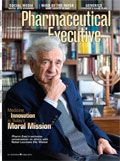Taking a Less-Generic Route to Generics
A leading industry player speaks out on what is fueling success in the sector
Generic drugs play a significant role in treatment decisions, helping to ensure access and reduce costs for millions of patients. Yet success is not guaranteed; the generics market presents specific business challenges requiring careful consideration. There remains a high demand for innovative medicines that address unmet needs and pinpoint challenging illnesses. The industry faces the imminent expiration of many patents, which has significant revenue implications for the whole system. Evolving legislation, including healthcare reform and the drive toward a biosimilar pathway, will impact the demand for generic drugs.

Timothy R. Wright
In this complex but opportunity-laden environment, generics companies must carve out new business strategies in order to compete.
Generics' Growing Presence
The rapid emergence of the generic drug industry has been fueled by pressures on Big Pharma. Meanwhile, decreasing pipeline innovation, combined with consumer resistance to rising branded drug costs in developed nations, has created significant opportunity for generic drug companies. The recent economic downturn—and the continual demand for greater access to care and less expensive generic drugs—provides further opportunity for generic manufacturers to thrive. Today, 75 percent of all medicines prescribed in the US are filled as generics.
The generics industry has not only grown in size, it has also changed in composition. Just a decade ago, the generics industry comprised a multitude of small companies. But with continued marketplace pressure on Big Pharma, major players began considering the generics space with fresh eyes; in the last two years alone, 11 major pharmaceutical companies created or acquired generics units, a magnitude equal to the total number of generics companies created by branded manufacturers between 1990 and 2008.
Big Pharma's entrance into the generic market, along with the growth of independent generics firms, signals stiffer competition in coming years, with volume spread across more players. As Mike Chace-Ortiz, senior director of product strategy for Thomson Reuters, noted at the June 2010 Argyle Executive Forum for Leadership in Pharmaceuticals and Biotechnology, the generics market will grow only slightly or be flat in the coming year. If this is indeed the case, prospering in the competitive world of generic drugs will require business strategies to transform—to become, as it were, "less generic."
Enter the Age of the 'Supergeneric'
While generics companies are not usually regarded as innovators, generic drugs require less capital investment than novel therapies. This opens the door for innovative development work in the so-called 'supergeneric' drug space—an area of new innovation leveraging existing competencies in both novel and generics models and specialty medicine channels. As opposed to commodity generics—which are bioequivalent clones of the original drug—supergenerics differ from the original product in formulation or method of delivery.
While supergenerics represent one path to renewed success, some generics companies have opted to develop proprietary molecules in order to tap into the lucrative innovative market. Before the generic firm Pliva was acquired by Barr Pharmaceuticals, it was responsible for the discovery of the highly successful antibiotic azithromycin. In 2002, the drug, eventually marketed by Pfizer as Zithromax, was the most-prescribed brand name oral antibiotic in the US, and the second-highest-selling antibiotic in the world.
Meanwhile, Teva has entered the marketplace with new chemical entities (NCEs). In addition to the more than 140 generics products it markets domestically, Teva is developing innovative drugs in the neurological and autoimmune therapeutic areas. Teva's major success has been Copaxone, which is now an important physician-prescribed treatment for multiple sclerosis (MS) in the US.
Getting Less Generic
Though seemingly counterintuitive, with Big Pharma's pipelines dwindling, generics companies are now poised to address therapeutic areas with unmet clinical needs. Many of these companies have honed knowledge around key health needs—specialty medical areas that are complex structurally or exist within complex regulatory environments—diagnostic medicine, growth hormone therapy, pain management, and oncology.
Firms like Teva are doing just that. Using a so-called 'distributed model'—combining internal and external assets to solve medical problems in new and creative ways—these firms are expanding their focus to include new areas of pharmaceutical development, such as new formulations and biosimilar development.
It starts by combining diagnostic and therapeutic assets, offering unique clinical opportunities to focus on medicine-delivery systems. In some cases, one company may utilize a technology from a second company to solve a medical need, which may be marketed by yet a third company that has the appropriate infrastructure to navigate complex regulations.
A modified R&D process is the driving force behind the distributed model. A single NCE takes between 10 years and 15 years to develop from discovery to patient access on the open market, with an average cost of $800 million to $1 billion. In an economic environment that demands cost-cutting measures and reduced R&D spending, a distributed model maximizes 'incremental innovation,' allowing companies to innovate by reformulating and combining drugs with innovative delivery systems, rather than investing millions in a novel therapy that may or may not provide unique patient benefit. Further, the distributed model can make a huge difference in driving forward projects like drug development for neglected diseases, for which needs are great but funds are scarce.
Focusing on areas such as pain and oncology, in which molecular targets are well understood, generics companies are providing patients with new diagnostic and treatment options. Successful approaches come in the form of new formulation utility, improved side-effect profiles, or achieving maximum therapeutic effect.
Finding the Balance
The time when all generics companies focused exclusively on the development of commodity generics—easy to manufacture, oral versions of drugs with few barriers to market entry—has passed. Increasing competition, low margins, and fewer new molecules entering the market have shaped generics industry survivors into more efficient market players.
If generics companies can balance both generics and NCE development—while deploying their channel and specialty medicine experience—they may be able to reap the benefits offered by both product types in the global healthcare environment. Governments are emphasizing cost containment and access to care, driving greater use of generics as alternatives to brand name drugs. Equally, if serious and chronic diseases are to be tackled effectively, there will be a continuing demand for innovative, disease-modifying drugs.
Non-generic pharmaceutical companies, too, stand to gain from co-opting the distributed model and allowing it to flourish in cooperative competition with traditional R&D. Building on external research through collaborative strategies will allow companies to increase their innovation, productivity, and ultimately transform their business. In this era of tremendous scientific potential and fast-paced advances, adapting to future marketplace needs means fundamentally rethinking business models and demonstrating a willingness to implement major changes.
Who will benefit if innovators and generic companies can adapt to this new business model? Ultimately, government payers, health providers, and patients will be the collective recipients of this best-practice adaptation. The call for change is in the air. All we need do is listen to societal demands.
Timothy R. Wright is president of pharmaceuticals segment at Covidien plc. He can be reached at tim.wright@covidien.com

The Misinformation Maze: Navigating Public Health in the Digital Age
March 11th 2025Jennifer Butler, chief commercial officer of Pleio, discusses misinformation's threat to public health, where patients are turning for trustworthy health information, the industry's pivot to peer-to-patient strategies to educate patients, and more.
Navigating Distrust: Pharma in the Age of Social Media
February 18th 2025Ian Baer, Founder and CEO of Sooth, discusses how the growing distrust in social media will impact industry marketing strategies and the relationships between pharmaceutical companies and the patients they aim to serve. He also explains dark social, how to combat misinformation, closing the trust gap, and more.